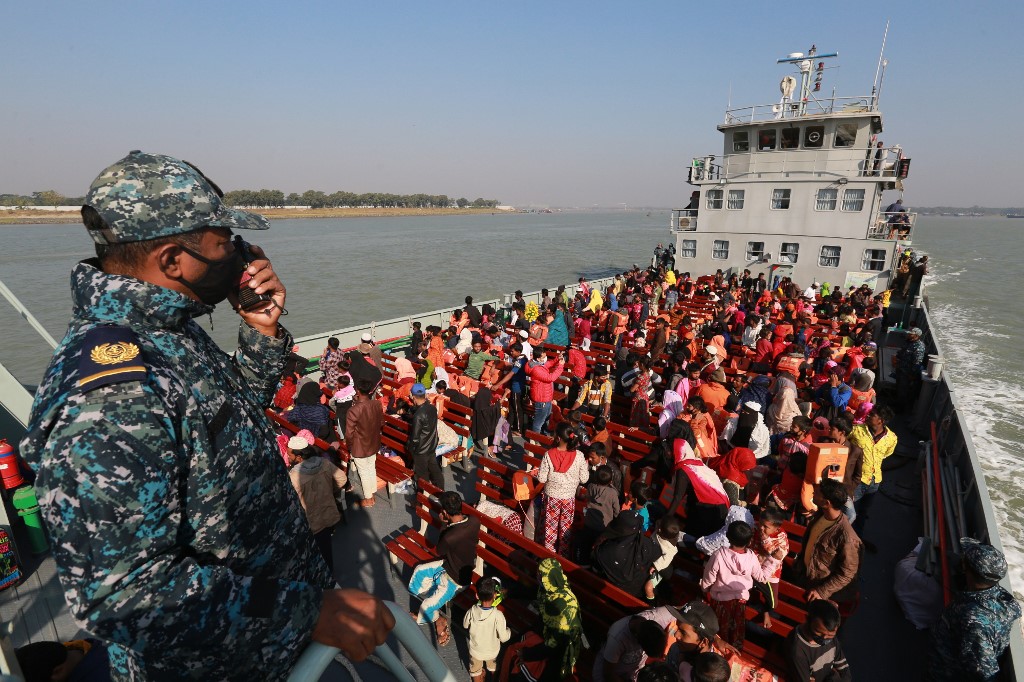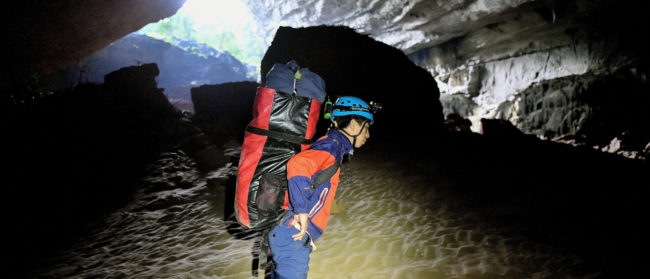Far from their dreams of returning to their homes in western Myanmar, Rohingya refugees dug into the hills of Cox’s Bazar in southern Bangladesh have sat uncomfortably in their exile.
Somewhere upwards of 800,000 people have scratched together a life in waiting in the camps near the coast of the Bay of Bengal. With a lack of options before them, about 3,500 Rohingya have since December taken a leap of faith and relocated to Bhasan Char, a small windswept and flood prone Bangladeshi island, as part of the opening stages of a temporary resettlement scheme planned by the national government.
Those who left may be escaping intense pressures back on the mainland, where on 14 January thousands of residents of the Nayapara camp saw local schools and homes engulfed in fire. Some, including the country office of UNICEF, have since described the early morning fires as an act of arson.
Over all the turbulence of refugee life swirls the constant hope for repatriation, an opportunity to resume life in the western Rakhine State of Myanmar, the traditional homeland for the predominantly Muslim Rohingya. While a 19 January tripartite meeting between representatives of Bangladesh, Myanmar and facilitating China left Bangladeshi Foreign Secretary Masud Bin Momen “cautiously optimistic” for repatriation starting as soon as this year, others remain deeply skeptical – especially when the Rohingya themselves are left out of such discussions.
“People are expecting good results from [the meeting], but for me, I’m not expecting that at all,” said Ro Sawyedollah, a Rohingya youth activist living in the camps of Cox’s Bazar, speaking the day before the meeting.
While he knew others who were hopeful with the potential outcome of the three-way conversation, Sawyedollah viewed the lack of Rohingya at the table as a bad sign.
“Now China is trying to fix problems of another country, like Myanmar – but really they’re there to support Myanmar,” he told the Globe. “We’ve already had two dialogues with Myanmar and they didn’t give proper answers to our questions.”
The biggest of those questions have centred around how the Rohingya might go back to Myanmar, as well as what reception they’ll find when they arrive. By and large, the Rohingya do not have citizenship in their home country and are not recognised as an indigenous race under the 1982 Citizenship Law.
Though state programmes in the past, such as the controversial National Verification Card, have offered the Rohingya some rights in Myanmar, the state has not yet considered plans for repatriation that would include a path to citizenship.
For observers in the human rights world, the lack of clear political solutions for the Rohingya remains a major hurdle in any talks of population return.
“Repatriation at this time is closer to refoulement,” said John Quinley, of the non-governmental organisation Fortify Rights. “Returning Rohingya to a situation of ongoing persecution and violence is not the answer, and the world should be pushing Myanmar to restore citizenship rights for the Rohingya, halting the [National Verification Card] process, and holding perpetrators accountable.”

For now, plans to do such a thing seem improbable or, at best, far away.
Myanmar’s civilian leader Aung San Suu Kyi, long viewed as a champion of democracy in the country, in late 2019 defended the Burmese military’s August 2017 campaign against the Rohingya minority in front of the International Court of Justice (ICJ). In doing so, she fought back against charges of genocide levelled against the military, known as the Tatmadaw, after their so-called “clearance operations” of Rohingya settlements in Rakhine State during a crackdown on ethnic armed group the Arakan Rohingya Salvation Army.
Though the ICJ told Suu Kyi to take provisional measures to safeguard the Rohingya still living in her country, there has been little evidence of that in the year since. Meanwhile, the situation for the Rohingya in Bangladesh has only grown more tense, as their time in exile has dragged on and their relationship with their hosts become strained.
We’re living in the country of another government. They were kind to us when we came from Myanmar, but day by day, they are getting frustrated with us
Sawyadollah said rumours are still burning as to the causes of the Nayapara fire, adding that some people in the camps were attributing the events to various groups competing for influence among the refugees.
Even before the burning, the activist felt that administration of the camps had been growing more strict, particularly in terms of movement between encampments. Over the past year, authorities in Bangladesh restricted access from outside the camps as a Covid-19 prevention method, but Sawyedollah felt recent actions had a different root.
“We’re living in the country of another government. They were kind to us when we came from Myanmar, but day by day, they are getting frustrated with us,” he said.
In that context, both human rights observers and those living in camp remain wary of the recent push to relocate the refugees to Bhasan Char, a small, silty island of about 40-square-kilometres set about 60 km from the mainland in the Bay of Bengal.
The plan to house Rohingya on the island has been in the works for about five years, though actual resettlement just began 4 December. The island itself has been hit with cyclones in the past, and though representatives of the Bangladeshi government says it has spent more than $350 million in development funds to make it safe and suitable for as many as 100,000 people, the facilities of the Bhasan Char haven’t yet been inspected by UN agencies, a status that has given pause to international donor and non-governmental organisations.
In September 2019, journalists from German news agency Deutsche Welles visited the island and judged it, at that point anyway, as appearing to offer better conditions than the makeshift camps at Cox’s Bazar. The lead architect for the project described it to the journalists as a “paradise” for the Rohingya, while pushing back against critics who branded Bhasan Char a prison island.
Last month, Phil Robertson, head of the Asia office of rights organisation Human Rights Watch, renewed that line, dubbing Bhasan Char “the Rohingya Alcatraz”, in reference to the infamous former prison of the US.
Not all foreign aid workers see it that way. James Munn, the Bangladesh country coordinator for the Norwegian Refugee Council (NRC), believed labelling the island as such “undermines the intention of the government” there.

“I don’t think they see it as that,” he told the Globe. Munn didn’t endorse Bhasan Char though, offering pros and cons that he summed up as a “wait-and-see” situation for any final judgment.
In the list of positives, and with Bhasan Char still mostly empty with only some 3,500 on the island, Munn said Rohingya people who have resettled there are reporting back mostly good things.
“Our own beneficiaries and volunteers who have not yet gone have told us they are looking forward to [moving],” he said. “They’ve heard from others there that there is space, which they don’t have in congested camps, and there’s quiet. One person told us they were able to sleep properly for the first time in years.”
But the negative points are still heavy, and include allegations of physical abuse and deprivation by Bangladeshi Naval authorities from before the resettlement in October, when a group of more than 300 Rohingya were quarantined on the island while attempting to flee Bangladesh by boat.
In terms of the ongoing relocation, Munn said that, as far as he knows, volunteers who decide to go to Basan Char don’t currently have the option to return to the mainland. He also added a key caveat to the term ‘volunteers’, saying it’s not always clear how much refugees know or how they might be pushed by authorities to be resettled.
While the UN hasn’t yet gone to Bhasan Char, at least 22 local and national Bangladeshi civil society organisations are currently involved in supporting refugees on the island. Munn said NRC has been informed of another resettlement around the end of January of about 2,000 people, the largest group so far. The lack of international support for the Bhasan Char project had, by early December, reportedly stretched the capacity of groups to provide for the smaller group of Rohingya on the island at that time.
Most Rohingya are generally steadfast in their desire to return home to western Myanmar, and the activist Sawyedollah says repatriation is the only real solution for the refugees. But for those considering a layover in Bhasan Char, he said the decision comes down to conditions of the camps on the mainland. He said he’s spoken with many people to see why they had chosen or were considering a move to the island.
“I asked them lots of questions, and many said they want to see if there’s a better life in Basan Char,” Sawyedollah said. “They said they don’t know how it is. But they say they hope it will be better than this camp life.”


